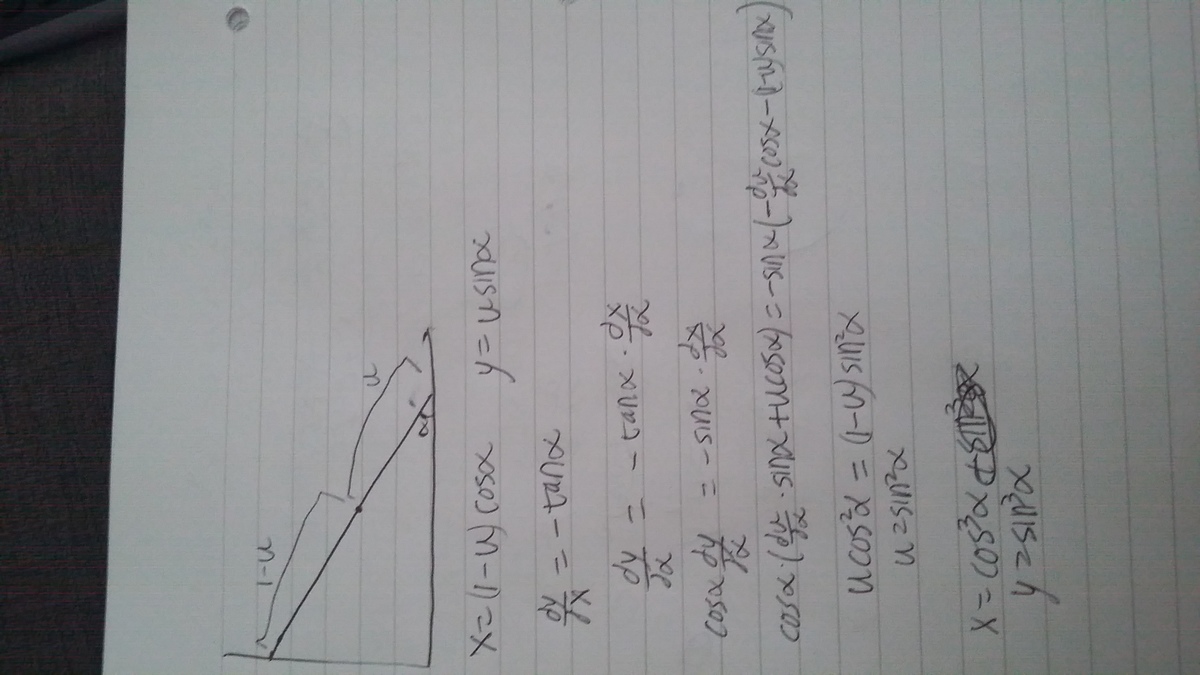A familiar curve!
A curve starts from ( 0 , 1 ) and ends at ( 1 , 0 ) (but it does not include the two points), and the whole curve is in the first quadrant.
If we draw any tangent line of the curve, and the tangent intersects the x -axis and y -axis at point P and Q respectively, then the length of P Q is always equal to 1.
What is the length of the curve?
The answer is 1.5.
This section requires Javascript.
You are seeing this because something didn't load right. We suggest you, (a) try
refreshing the page, (b) enabling javascript if it is disabled on your browser and,
finally, (c)
loading the
non-javascript version of this page
. We're sorry about the hassle.
3 solutions

From there, finding the arc length is pretty standard.
The shape is an Astroid , to see why you may want to check out this problem and it's solutions. An astroid has parametrization ( cos 3 t , sin 3 t ) , so it's length in the first quadrant is ∫ 0 2 π ( d t d sin 3 t ) 2 + ( d t d cos 3 t ) 2 d t = ∫ 0 2 π ( 3 ( sin 2 t ) cos t ) 2 + ( 3 ( cos 2 t ) sin t ) 2 d t
Which simplifiest to 2 3 ∫ 0 2 π sin ( 2 t ) d t = 1 . 5
Find q with respect to p : Solve [ EuclideanDistance [ { p , 0 } , { 0 , q } ] = 1 , q ] is q = 1 − p 2 .
Draw a picture using various lines connecting the { p , 0 } and { 0 , 1 − p 2 } points with a quarter circle for comparison:
Now, it is known that the arclength is less than that of a quarter circle with a radius of 1.
Following the procedure for computing the envelope of a family of curves and then computing the arc-length of that curve gives the desired answer, which is 2 3 .
The members of the family of curves (straight lines in this case) are: y = 1 − p 2 − p 1 − p 2 x .
∂ p ∂ ( yn − y ) is − p 2 1 − p 2 x − 1 − p 2 x + 1 − p 2 p .
Solving for p − p 2 1 − p 2 x − 1 − p 2 x + 1 − p 2 p = 0 gives three roots, but only one real root: 3 x
Substituting that value for p into the original family formula gives the curve formula: y = ( 1 − x 2 / 3 ) 3 / 2 .
Drawing both the original family of straight lines and the curve as a broad, red curve shows that it is probably correct.
∫ ( ∂ x ∂ ( 1 − x 2 / 3 ) 3 / 2 ) 2 + ( ∂ x ∂ x ) 2 d x gives 2 3 x 2 3 .
∣ ∣ ∣ ∣ ∣ 2 3 x 2 3 ∣ ∣ ∣ ∣ ∣ x = 0 1 = 2 3